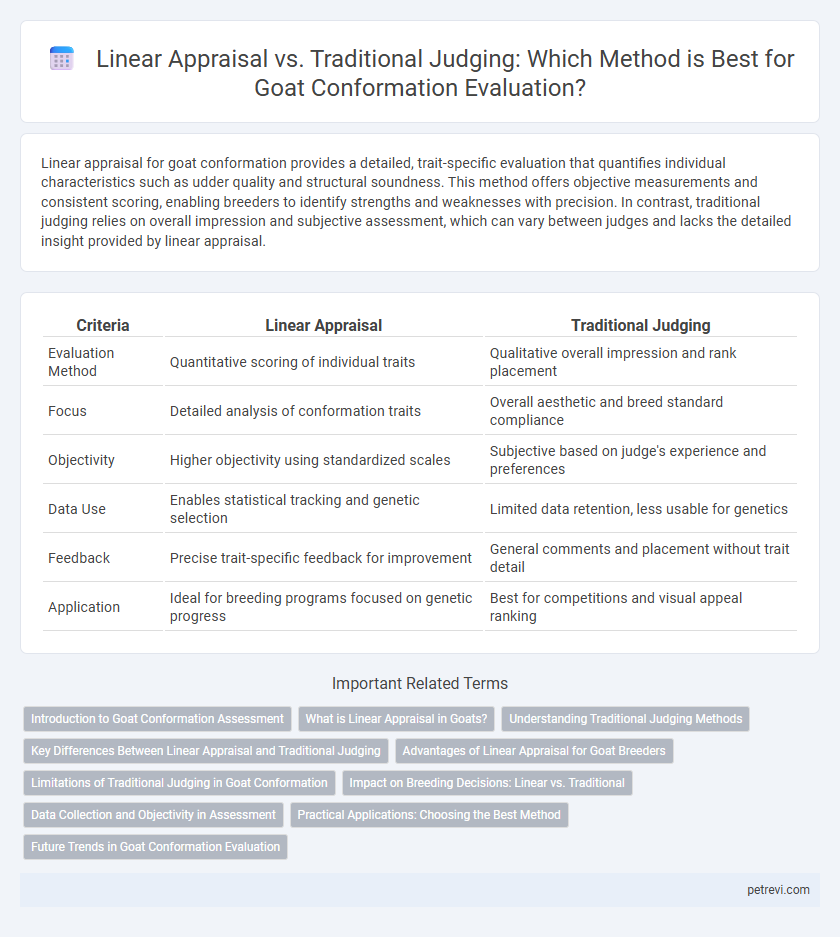Linear appraisal for goat conformation provides a detailed, trait-specific evaluation that quantifies individual characteristics such as udder quality and structural soundness. This method offers objective measurements and consistent scoring, enabling breeders to identify strengths and weaknesses with precision. In contrast, traditional judging relies on overall impression and subjective assessment, which can vary between judges and lacks the detailed insight provided by linear appraisal.
Table of Comparison
| Criteria | Linear Appraisal | Traditional Judging |
|---|---|---|
| Evaluation Method | Quantitative scoring of individual traits | Qualitative overall impression and rank placement |
| Focus | Detailed analysis of conformation traits | Overall aesthetic and breed standard compliance |
| Objectivity | Higher objectivity using standardized scales | Subjective based on judge's experience and preferences |
| Data Use | Enables statistical tracking and genetic selection | Limited data retention, less usable for genetics |
| Feedback | Precise trait-specific feedback for improvement | General comments and placement without trait detail |
| Application | Ideal for breeding programs focused on genetic progress | Best for competitions and visual appeal ranking |
Introduction to Goat Conformation Assessment
Goat conformation assessment evaluates structural correctness and overall physical traits impacting productivity and health. Linear appraisal uses quantified scores for individual traits, offering precise, repeatable data for breeders to track genetic progress. Traditional judging relies on subjective overall impressions, often varying between judges and making objective comparison and selection more difficult.
What is Linear Appraisal in Goats?
Linear appraisal in goats is a detailed evaluation method that scores individual physical traits on a scale, providing objective data about body structure and function. Unlike traditional judging, which often relies on overall subjective impressions, linear appraisal breaks down conformation into measurable traits such as udder quality, leg structure, and body capacity. This approach enables breeders to make precise selection decisions, improving genetic progress and herd quality over time.
Understanding Traditional Judging Methods
Traditional judging methods for goat conformation rely on subjective evaluation where judges use established criteria such as body structure, muscle development, and breed standards to assign scores or rankings. This approach emphasizes visual assessment and experience-based judgment, often focusing on key traits like skeletal correctness, udder quality, and overall balance. While effective for immediate comparison, traditional judging can lack the quantitative precision found in linear appraisal systems, which break down traits into measurable components.
Key Differences Between Linear Appraisal and Traditional Judging
Linear appraisal for goat conformation quantifies specific traits on a scale, allowing precise measurement of attributes like body capacity, muscling, and teat placement. Traditional judging relies on overall subjective assessment, emphasizing balance, style, and breed character without numerical scoring. Key differences include objectivity and repeatability in linear appraisal versus holistic and experience-based evaluation in traditional judging.
Advantages of Linear Appraisal for Goat Breeders
Linear appraisal provides goat breeders with precise, quantifiable data on specific traits such as body capacity, dairy strength, and teat placement, allowing for targeted genetic improvement. This method reduces subjectivity inherent in traditional judging by using standardized scoring, promoting consistency across different evaluators and herds. Enhanced data-driven selection through linear appraisal accelerates breeding decisions, improving overall herd quality and productivity.
Limitations of Traditional Judging in Goat Conformation
Traditional judging for goat conformation often relies on subjective visual assessments that can lead to inconsistency and bias among judges. This method limits the ability to capture detailed quantitative traits and subtle genetic differences critical for breeding decisions. Consequently, traditional judging may overlook performance-related traits and objective standards that linear appraisal systems can more accurately evaluate.
Impact on Breeding Decisions: Linear vs. Traditional
Linear appraisal provides detailed, quantifiable trait scores that enable precise selection for breeding goals, improving genetic progress in goat populations. Traditional judging relies on overall visual impressions and ranking, which can introduce subjectivity and less consistent criteria, potentially affecting accuracy in breeding decisions. By emphasizing measurable traits over general appearance, linear appraisal enhances genetic evaluation and supports more informed, data-driven breeding strategies.
Data Collection and Objectivity in Assessment
Linear appraisal in goat conformation emphasizes quantifiable traits measured on a scale, enhancing data collection precision and enabling objective comparisons across animals. Traditional judging relies heavily on subjective evaluation by experts, often leading to variability in assessments due to individual bias. The structured data acquisition in linear appraisal promotes consistent decision-making and facilitates genetic progress by identifying specific traits tied to productivity and breed standards.
Practical Applications: Choosing the Best Method
Linear appraisal offers precise scoring of individual traits such as stature, udder attachment, and leg structure, enabling targeted breeding decisions for improved goat conformation. Traditional judging relies on overall visual impression and expert experience, which can lead to subjective variability but is faster during shows. Practical applications favor linear appraisal for detailed genetic progress in herds, while traditional judging remains useful for quick evaluation in competitive settings.
Future Trends in Goat Conformation Evaluation
Linear appraisal offers precise quantification of traits such as body structure, udder quality, and muscling, enabling breeders to make data-driven decisions in goat conformation. Traditional judging relies on visual assessment and subjective scoring, which may introduce inconsistencies and limit genetic improvement. Future trends are shifting towards integrating digital imaging and machine learning with linear appraisal to enhance accuracy and standardize evaluations across diverse goat populations.
Linear appraisal vs Traditional judging for Goat conformation Infographic

 petrevi.com
petrevi.com